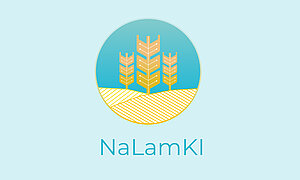March 1, 2021
The research project NaLamKI, short for "sustainable agriculture using AI”, excelled in the field of agriculture during the second funding call of the "Artificial Intelligence Innovation Competition”. The competition is organized by the German Federal Ministry for Economic Affairs and Energy (BMWi). With it, the BMWi promotes outstanding approaches for new forms of AI-based platform economies in important sectors of the German economy. NaLamKI, which kicked off at the beginning of the year, will receive government funding of around 10 million euros over its three-year term until December 2023. The Fraunhofer Heinrich Hertz Institute (HHI) is involved in the joint project with its departments "Wireless Communications and Networks" and "Vision and Imaging Technologies." The Fraunhofer HHI research teams will receive around 3.3 million euros of the funding total.
As digitization of the agricultural sector increases, so do the requirements for the quantity and availability of reliable (real-time) data for all players along the agricultural value chain. To meet these requirements, the NaLamKI project aims at developing a cloud-based SaaS (software-as-a-service) platform with open interfaces for providers from the upstream and downstream sectors of agriculture, the industry as well as for service providers who specialize in applications for crop production. This will make it possible to realize the full potential of a digitized agriculture.
By combining sensor and machine data obtained by remote sensing (satellites, drones), ground sensors, robotics, manual data collection and inventory data, a valuable data pool will be created. Modern AI methods and (partially) autonomous vehicles and agent networks can use this data pool to make agricultural processes such as irrigation, fertilization and pest control more sustainable, efficient and transparent. For this purpose, NaLamKI provides the possibility of a high-dimensional analysis and fusion of all aggregated data. By building an International Data Space for Agriculture (IDSA) and GAIA-X-compliant services, the platform will act interoperably between different centralized and decentralized cloud providers and users. In this process, data sovereignty is ensured at all times. NaLamKI thus supports an optimal resource allocation, improves nutrient and crop protection management, addresses the impacts of climate change and the shortage of skilled labour, and, ultimately, contributes to nutrition protection.
Fraunhofer HHI’s "Vision and Imaging Technologies" department will develop new methods for AI-based and modality-wise analysis of satellite, drone, ground, and inventory sensor data and their fusion. Specifically, a-priori and expert knowledge will be interactively integrated here. Furthermore, Fraunhofer HHI researchers will develop concepts for the explainability and plausibility of the generated AI models for the agricultural staff. Another focus of the project is networking and signal transmission between actuators, sensors, cloud nodes and other computers. Here, the "Wireless Communication and Networks" department develops concepts for the (wireless) communication infrastructure to realize the connection of sensor and machine data to the cloud, as well as to ensure the communication of the decentralized AI among each other.
Alongside Fraunhofer HHI, the JKI's Research Center for Agricultural Remote Sensing, DFKI, NT Neue Technologien AG, John Deere GmbH & Co. KG, Optoprecision GmbH, Planet Labs Germany GmbH, Robot Makers GmbH, the TU Kaiserslautern and the University of Hohenheim are involved in the NaLamKI project.
